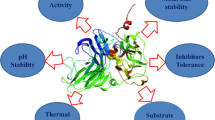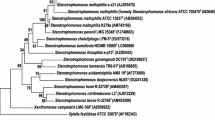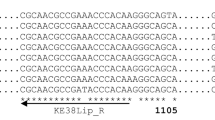Abstract
A gene encoding extracellular lipase was cloned and characterized from metagenomic DNA extracted from hot spring soil. The recombinant gene was expressed in E. coli and expressed protein was purified to homogeneity using hydrophobic interactions chromatography. The mature polypeptide consists of 388 amino acids with apparent molecular weight of 43 kDa. The enzyme displayed maximum activity at 50°C and pH 9.0. It showed thermal stability up to 40°C without any loss of enzyme activity. Nearly 80% enzyme activity was retained at 50°C even after incubation for 75 min. However above 50°C the enzyme displayed thermal instability. The half life of the enzyme was determined to be 5 min at 60°C. Interestingly the CD spectroscopic study carried out in the temperature range of 25–95°C revealed distortion in solution structure above 35°C. However the intrinsic tryptophan fluorescence spectroscopic study revealed that even with the loss of secondary structure at 35°C and above the tertiary structure was retained. With p-nitrophenyl laurate as a substrate, the enzyme exhibited a K m , V max and K cat of 0.73 ± 0.18 μM, 239 ± 16 μmol/ml/min and 569 s−1 respectively. Enzyme activity was strongly inhibited by CuCl2, HgCl2 and DEPC but not by PMSF, eserine and SDS. The protein retained significant activity (~70%) with Triton X-100. The enzyme displayed 100% activity in presence of 30% n-Hexane and acetone.




Similar content being viewed by others
References
Jaeger KE, Dijkstra BW, Reetz MT (1999) Bacterial biocatalysts; molecular biology, three dimensional structures, and biotechnological applications of lipases. Annu Rev Microbiol 53:315–351
Kim S, Lee SB (2004) Thermostable estrase from thermoacidophilic archeon: Purification and characterization of enzymatic resolution of chiral compound. Biosci Biotechnol Biochem 68:2289–2298
Rubin B, Dennis EA (eds) (1997) Lipases part B. Enzyme characterization and utilization. In: Methods in enzymology, vol 286. Academic Press, San Diego, pp 1–563
Pouderoyen V, Eggert T, Jaeger KE, Dijkstra BW (2001) The crystal structure of Bacillus Subtili lipase; a minimal α/β hydrolase fold enzyme. J Mol Biol 309:215–226
Jeong ST, Kim HK, Jun KS, Chi SW, Pan JG, Oh TK, Ryu ES (2002) Novel Zinc-binding center and a temperature switch in the Bacillus stearothermophilus L1 lipase. J Biol Chem 277:17041–17047
Kristjansson JK (1989) Thermophilic organisms as sources of thermostable enzymes. Trends Biotechnol 7:349–353
Mozhaev VV (1993) Mechanisms-based strategies for protein thermostabilization. Trends Biotechnol 11:88–95
Ladenstein R, Ren B (2006) Protein disulfides and protein disulfide oxidoreductases in hyperthermophiles. FEBS Journal. 273:4170–4185
Li H, Zhang X (2005) Characterization of thermostable lipase from thermophilllic Geobacillus sp. TW1. Prot Exp Puri 42:153–159
Zhang A, Ranjun G, Diao N, Xie G, Gao G, Cao S (2009) Cloning, expression and characterization of an organic solvent tolerant lipase from Pseudomonas fluorescens. J Mol Catal B 56:78–84
Kampen MDV, Rosenstein R, Gotz F, Engmond MR (2001) Cloning, purification and characterisation of Staphylococcus warneri lipase 2. Biochim Biophys acta 1544:229–241
Amann RI, Ludwig W, Schleifer KH (1995) Phylogenetic identification and In situ detection of individual microbial cells without cultivation. Microbiol Rev 59:143–169
Hugenholtz P, Pace NR (1996) A molecular phylogenetic approach to the natural microbial world: the biotechnological potential. Trends Biotechnol 14:190–197
Pace NR, Stahl DA, Lane DJ, Olsen GJ (1985) Analyzing natural microbial populations by rRNA sequences. ASM News 51:4–12
Beja O, Aravind L, Koonin EV, Suzuki MT, Hadd A, Nguyen LP, Jovanovich SB, Gates CM, Feldman RA, Spudich JL, Spudich EN, DeLong EF (2000) Bacterial rhodopsin; evidence for a new type of phototrophy in the sea. Science 289:1902–1906
MacNeil IA, Tiong CL, Minor C, August PR, Grossman TH, Loiacono KA, Lynch BA, Phillips T, Narula S, Sundaramoorthi R, Tyler A, Aldredge T, Long H, Gilman M, Holt D, Osburne MS (2001) Expression and isolation of antimicrobial small molecules from soil DNA libraries. J Mol Microbiol Biotechnol 3:301–308
Majernik A, Gottschalk G, Daniel R (2001) Screening of Environmental DNA Libraries for the presence of genes conferring Na+ (Li+)/H+ antiporter activity on Escherichia coli; characterization of the recovered genes and the corresponding gene products. J Bacteriol 183:6645–6653
Rees HC, Grant S, Brian J, Grant WD, Heaphy S (2003) Detecting cellulose and esterase enzyme activities encoded by novel genes present in environmental DNA libraries. Extremophiles 7:415–421
Kourist R, Hari Krishna S, Patel JS, Bertnek F, Hitchman TS, Weiner DP, Bornscheuer UT (2007) Identification of a metagenome-derived esterase with high enantioselectivity in the kinetic resolution of arylaliphatic tertiary alcohols. Org Biomol Chem 5:3310–3313
Lammle K, Zipper H, Breuer M, Hauer B, Buta C, Brunner H, Rupp S (2007) Identification of novel enzymes with different hydrolytic activities by metagenome expression cloning. J Biotechnol 127:59–575
Elend C, Schmeisser C, Leggewie C, Babiak P, Carballeira JD, Steele HL, Reymond JL, Jaeger KE, Streit WR (2006) Isolation and biochemical characterization of two novel metagenome-derived esterases. Appl Environ Microbiol 72:3637–3645
Lee M, Lee C, Oh T, Song JK, Yoon J (2006) Isolation and characterization of a novel lipase from a metagenomic library of tidal flat sediments: evidence for a new family of bacterial lipases. Appl Environ Microbiol 72:7406–7409
Bertram M, Hildebrandt P, Weiner DP, Patel JS, Bartnek F, Timothy S, Hitchman TS, Bornscheuer UT (2008) Characterization of lipases and esterases from metagenomes for lipid modification. J Am Oil Chem Soc 85:47–53
Bell PJL, Sunna A, Gibbs MD, Curach NC, Nevalainen H, Bergquist PL (2002) Prospecting for novel lipase using PCR. Microbiology 148:2283–2291
Tirawongsaroj P, Sriprang R, Harnpicharnchai P, Thongaram T, Champreda V, Tanapongpipat S, Pootanakit K, Eurwilaichitr L (2008) Novel thermophilic and thermostable lipolytic enzymes from a Thailand hot spring metagenomic library. J Biotechnol 133:42–49
Fan Z, Yue C, Tang Y, Zhang Y (2009) Cloning, sequence analysis and expression of bacterial lipase-coding DNA fragments from environment in Escherichia coli. Mol Biol Rep 36:1515–1519
Zhou J, Bruns MA, Tiedje JM (1996) DNA recovery from soils of diverse composition. App Env Microbiol 62:316–322
Sharma PK, Capalsh N, Kaur J (2007) An improved method for single step purification of metagenomic DNA. Mol Biotechnol 36:61–63
Sambrook J, Fritsch E, Maniatis T (1989) Molecular cloning: a laboratory manual, 2nd edn. Cold spring Harbor Laboratory, New York
Sanger F, Nicklen S, Coulsion AR (1977) DNA sequencing with chain terminating inhibitors. Proc Nat Acad of Sci USA 74:5463–5467
Laemmli UK (1970) Cleavage of structural proteins during the assembly of the head of bacteriophage T4. Nature 15:680–685
Sigurgisladottir S, Konraosdottir M, Jonsson A, Kristjansson JK, Matthiasson E (1993) Lipase activity of thermophilic bacteria from icelandic hot springs. Biotechnol Lett 15:361–366
Castro RQ, Diaz P, Alfaro GV, Gracia HS, Ros RO (2009) Gene cloning, expression and characterization of the Geobacillus thermoleovorans CCR11 thermoalkaliphilic Lipase. Mol Biotechnol 42:75–83
Kim HK, Park SY, Lee JK, Oh TK (1998) Gene cloning and characterization of thermostable lipase from Bacillus stearothermophilus L1. Biosci Biotechnol Biochem 62:66–71
Sinchaikul S, Sookkheo B, Phutrakul S, Pan FM, Chen ST (2001) Optimization of a thermostable lipase from Bacillus stearothermophilus P1; overexpression, purification, and characterization. Prot Exp Puri 22:388–398
Soliman NA, Knoll M, Fattah YRA, Schmid RD, Lange S (2007) Molecular cloning and characterization of thermostable esterase and lipase from Geobacillus thermoleovorans YN isolated from desert soil in Egypt. Process Biochem 42:1090–1100
Chandrayan KS, Dhaunta N, Guptasarma P (2008) Expression, purification, refolding and characterization of a putative lysophospholipase from Pyrococcus furiosus: retention of structure and lipase/esterase activity in the presence of water-miscible organic solvents at high temperatures. Prot Exp Puri 59:327–333
Palomo JM, Muñoz G, Fernández-Lorente G, Mateo C, Fernández-Lafuente R, Guisán JM (2002) Interfacial adsorption of lipases on very hydrophobic support (octadecyl-Sepabeads): immobilization, hyperactivation and stabilization of the open form of lipases. J Mol Catal B 19(20):279–286
Nawani N, Kaur J (2000) Purification, characterization and thermostability of lipase from a thermophilic Bacillus sp. Mol Cell Biochem 206:91–96
Saxena RK, Sheoran A, Giri B, Davidson WS (2003) Purification strategies for microbial lipases. J Microbiol Methods 52:1–18
Pastore GM, Costa VSR, Koblitz MGB (2003) Partial purification and biochemistry characterization of an extracellular lipase obtained from new Rhizopus sp stream. Ciência e Tecnologia de Alimentos 23(2):135–140
Pencreac’h G, Barrati JC (1996) Hydrolysis of p-nitrophenyl palmitate in n-heptane by the Pseudomonas cepacia lipase: a simple test for the determination of lipase activity in organic media. Enz Microbial Tech 18:417–422
Choi WC, Kim MH, Ro HS, Sang RR, Oh TK, Lee JK (2005) Zinc in lipase L1 from Geobacillus stearothermophilus L1 and structural implications on thermal stability. FEBS Lett 579:3461–3466
Geourjon C, Deleage G (1995) SOPMA: Significant improvements in protein secondary structure prediction by consensus prediction from multiple alignments. Comput Appl Biosci 11:681–684
Nakatani T, Hiratake J, Yoshikawa K, Nishioka T, Oda J (1992) Chemical inactivation of lipase in organic solvent: a lipase from Pseudomonas aeruginosa TE3285 is more like a typical serine enzyme in an organic solvent than in aqueous media. Biosci Biotechnol Biochem 56:1118–1123
Dannert CS, Sztajer H, Stocklein W, Menge U, Schmid RD (1994) Screening, purification and properties of a thermophilic lipase from Bacillus thermocatenulatus. Biochim Biophy Acta 1214:43–53
Jiang Y, Zhou X, Chen Z (2009). Cloning, expression and biochemical characterization of a thermostable lipase from Geobacillus stearothermophilus JC. World J Microbiol Biotechnol. doi:10.1007/s11274-009-0213-1
Sabri S, Zaliha NR, Rahman R, Leow CT, Basri M, Salleh B (2005) Secretory expression and characterization of a highly Ca2 + activated thermostable L2 lipase. Prot Exp Puri 68:161–166
Nawani N, Dosanjh NS, Kaur J (1998) A novel thermostable lipase from a thermophilic Bacillus sp.: characterization and esterification studies. Biotechnol Lett 20:997–1000
Acknowledgments
The Senior research fellowship to PKS by CSIR and financial support to Dr. Jagdeep Kaur by Department of Science and Technology, India and CSIR, New Delhi is duly acknowledged.
Author information
Authors and Affiliations
Corresponding author
Electronic supplementary material
Below is the link to the electronic supplementary material.
11033_2011_1038_MOESM1_ESM.tif
Supplementary Material 1. Multiple sequence alignment of JkP01, accession number FJ 392756 [lipase, uncultured bacterium] at protein level with some of the closely related lipases at Gene Database. U78785 [lipase, Bacillus stearothermophilus L1], AY786185 [TW1 lipase Geobacillus sp. TW1], AF237623 [P1 lipase Bacillus stearothermophilus P1.The catalytic triad of the lipase is text as red color, the conserve dipeptide is text as blue and the conserve pentapeptide having catalytic serine residue text as green. (TIFF 162 kb)
11033_2011_1038_MOESM2_ESM.tif
Supplementary Material 2: SDS PAGE analysis of recombinant protein Lane1. Protein molecular weight marker, Lane2. Purified lipase protein (4.8 μg) (TIFF 96 kb)
Rights and permissions
About this article
Cite this article
Sharma, P.K., Singh, K., Singh, R. et al. Characterization of a thermostable lipase showing loss of secondary structure at ambient temperature. Mol Biol Rep 39, 2795–2804 (2012). https://doi.org/10.1007/s11033-011-1038-1
Received:
Accepted:
Published:
Issue Date:
DOI: https://doi.org/10.1007/s11033-011-1038-1




